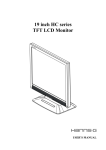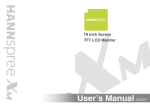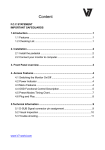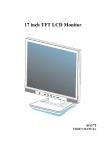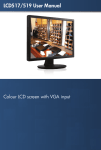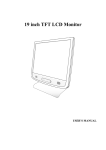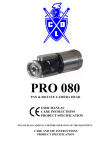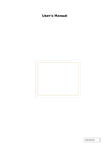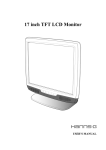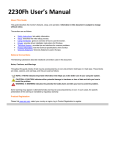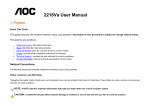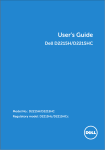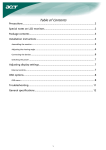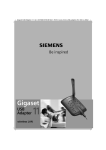Download Hanns.G HN Series User's Manual
Transcript
19 inch HN Series
TFT LCD Monitor
USER’S MANUAL
User’s Manual
Before operating the monitor, please read this manual thoroughly. This manual should be
retained for future reference.
FCC Class B Radio Frequency Interference Statement
This equipment has been tested and found to comply with the limits for a Class B digital
device, pursuant to Part 15 of the FCC Rules. These limits are designed to provide
reasonable protection against harmful interference in a residential installation. This
equipment generates, uses and can radiate radio frequency energy, and if not installed and
used in accordance with the instructions, may cause harmful interference to radio
communications. However, there is no guarantee that interference will not occur in a
particular installation. If this equipment does cause harmful interference to radio or
television reception, which can be determined by turning the equipment off and on, the user
is encouraged to try to correct the interference by one or more of the following measures:
Reorient or relocate the receiving antenna.
Increase the separation between the equipment and receiver.
Connect the equipment into an outlet on a circuit different from that to which the
receiver is connected.
Consult the dealer or an experienced radio/TV technician for help.
The device complies with Parts 15 of the FCC Rule. Operation is subject to the following
two conditions﹕ (1) this device may not cause harmful interference﹔ and (2) this device
must accept any interference received, including interference that may cause undesired
operations.
CANADA
This Class B digital apparatus meets all requirements of the Canadian Interference-Causing
Equipment Regulation.
This device complies with requirement of EMC directive 89/336/EEC with regard to
Electromagnetic Compatibility, and 73/23/EEC and 93/68/EEC with regard to Low Voltage
directive.
Socket-outlet shall be near the equipment and shall be accessible.
2
User’s Manual
Congratulations!
The display you have just purchased carries the TCO’03
Displays label. This means that your display is designed,
manufactured and tested according to some of the strictest
quality and environmental requirements in the world. This makes
for a high performance product, designed with the user in focus
that also minimizes the impact on our natural environment.
Some of the features of the TCO’03 Display requirements:
Ergonomics
•
Good visual ergonomics and image quality in order to improve the working environment
for the user and to reduce sight and strain problems. Important parameters are
luminance, contrast, resolution, reflectance, colour rendition and image stability.
Energy
•
•
Energy-saving mode after a certain time – beneficial both for the user and the
environment
Electrical safety
Emissions
•
•
Electromagnetic fields
Noise emissions
Ecology
•
•
The product must be prepared for recycling and the manufacturer must have a certified
environmental management system such as EMAS or ISO 14 001
Restrictions on
{ chlorinated and brominated flame retardants and polymers
{ heavy metals such as cadmium, mercury and lead.
The requirements included in this label have been developed by TCO Development in
cooperation with scientists, experts, users as well as manufacturers all over the world.
Since the end of the 1980s TCO has been involved in influencing the development of IT
equipment in a more user-friendly direction. Our labelling system started with displays in
1992 and is now requested by users and IT-manufacturers all over the world.
For more information, please visit
www.tcode velopment.com
3
User’s Manual
Recycling Information
We, the HannStar Display Corp. care very much about our environment
protection strategy and firmly believe that it helps us have healthier earth via appropriate
treatment and recycling of industrial technology devices at the end-of-life.
These devices contain recyclable materials, which can be re-decomposed and re-integrated
into
brand-new marvels. On the contrary, other material can be classified to hazardous and
poisoned
substances. We strongly encourage you to contact the provided information to recycle this
product.
United State : http://newyork.earth911.org/
Asia : http://recycle.epa.gov.tw/public/public4_2.htm
Europe :
Ireland
Company : McGrath Environmental Consultants Ltd.
Contact Person : Ms. McGrath Clodagh
Address: 20 Lower John Street, Cork, Ireland.
Tel : 021 4554833
Fax : 021 4505805
Norway :
Company : Bergfald & Co as
Contact Person : Mr. Solevåg Øystein
Address : Solavågsvegen 90, EIDSNES, NORWAY ,Post Code : N-6037
Tel : +47 40 23 47 05 Fax : +47 70 19 40 17
Web Site : http://www.bergfald.no/bergfald_english.html
United Kingdom :
Company : ARENA Network Contact Person : Dr. Tillotson Allen
Address : Bank Buildings Treforest Estate, Pontypridd, Rhondda Cynon Taff, Kindom Post
Code :
CF37 5UR
Tel : 01443 844001 Fax : 01443 844002
Web Site : http://www.arenanetwork.org
4
User’s Manual
TABLE OF CONTENTS
SAFETY NOTICE ........................................................................................... 6
PRECAUTIONS ......................................................................................... 6
SPECIAL NOTES ON LCD MONITORS ................................................... 7
BEFORE YOU OPERATE THE MONITOR .................................................... 8
FEATURES ................................................................................................ 8
CHECKING THE CONTENTS OF THE PACKAGE .................................. 8
INSTALLATION INSTRUCTIONS ............................................................. 9
POWER.................................................................................................... 10
CONTROLS AND CONNECTORS.......................................................... 11
ADJUSTING THE VIEWING ANGLE ...................................................... 12
OPERATING INSTRUCTIONS..................................................................... 13
GENERAL INSTRUCTIONS.................................................................... 13
FRONT PANEL CONTROL ..................................................................... 14
HOW TO ADJUST A SETTING ............................................................... 15
PLUG AND PLAY .................................................................................... 16
TECHNICAL SUPPORT (FAQ) .................................................................... 18
Q & A FOR GENERAL DEFECTIVE ....................................................... 18
ERROR MESSAGE & POSSIBLE SOLUTION ....................................... 19
APPENDIX ................................................................................................... 20
SPECIFICATIONS ................................................................................... 20
CONNECTOR PIN ASSIGNMENT .......................................................... 21
5
User’s Manual
SAFETY NOTICE
1. The changes or modifications not expressly approved by the party responsible for
compliance could void the user's authority to operate the equipment.
2. Shielded interface cables and AC power cord, if any, must be used in order to comply
with the emission limits.
3. The manufacturer is not responsible for any radio or TV interference caused by
unauthorized modification to this equipment. It is the responsibilities of the user to
correct such interference.
WARNING:
To prevent fire or shock hazard, do not expose the monitor to rain or moisture. Dangerously
high voltages are present inside the monitor. Do not open the cabinet. Refer servicing to
qualified personnel only.
PRECAUTIONS
• Do not use the monitor near water, e.g. near a bathtub, washbowl, kitchen sink, laundry
tub, swimming pool or in a wet basement.
• Do not place the monitor on an unstable cart, stand, or table. If the monitor falls, it can
•
•
•
•
•
•
•
•
injure a person and cause serious damage to the appliance. Use only a cart or stand
recommended by the manufacturer or sold with the monitor. If you mount the monitor on
a wall or shelf, use a mounting kit approved by the manufacturer and follow the kit
instructions.
Slots and openings in the back and bottom of the cabinet are provided for ventilation. To
ensure reliable operation of the monitor and to protect it from overheating, be sure these
openings are not blocked or covered. Do not place the monitor on a bed, sofa, rug, or
similar surface. Do not place the monitor near or over a radiator or heat register. Do not
place the monitor in a bookcase or cabinet unless proper ventilation is provided.
The monitor should be operated only from the type of power source indicated on the
label. If you are not sure of the type of power supplied to your home, consult your dealer
or local power company.
Unplug the unit during a lightening storm or when it will not be used for long period of
time. This will protect the monitor from damage due to power surges.
Do not overload power strips and extension cords. Overloading can result in fire or
electric shock.
Never push any object into the slot on the monitor cabinet. It could short circuit parts
causing a fire or electric shock. Never spill liquids on the monitor.
Do not attempt to service the monitor by yourself; opening or removing covers can
expose you to dangerous voltages and other hazards. Please refer all servicing to
qualified service personnel.
To ensure satisfactory operation, use the monitor only with UL listed computers which
have appropriate configured receptacles marked between 100 - 240V AC, Min. 5A.
The wall socket shall be installed near the equipment and shall be easily accessible.
6
User’s Manual
SPECIAL NOTES ON LCD MONITORS
The following symptoms are normal with LCD monitor and do not indicate a problem.
• Due to the nature of the fluorescent light, the screen may flicker during initial use. Turn
•
•
•
•
off the Power Switch and then turn it on again to make sure the flicker disappears.
You may find slightly uneven brightness on the screen depending on the desktop pattern
you use.
The LCD screen has effective pixels of 99.99% or more. It may include blemishes of
0.01% or less such as a missing pixel or a pixel lit all of the time.
Due to the nature of the LCD screen, an afterimage of the previous screen may remain
after switching the image, when the same image is displayed for hours. In this case, the
screen is recovered slowly by changing the image or turning off the Power Switch for
hours.
If the screen suddenly flashes erratically or the backlighting fails, please contact your
dealer or service center for repair. Do not attempt to repair the monitor yourself.
7
User’s Manual
BEFORE YOU OPERATE THE MONITOR
FEATURES
•
•
•
•
•
•
19” TFT Color LCD Monitor
Crisp, Clear Display for Windows
Recommended Resolutions: 1280 X 1024 @60Hz
EPA ENERGY STAR®
Ergonomic Design
Space Saving, Compact Case Design
CHECKING THE CONTENTS OF THE PACKAGE
The product package should include the following items:
LCD Monitor
(Reference only, the real feature is depended on selected model)
Screen
Base
Cables and User manual
Power Cord
VGA Cable
Audio Cable
User’s manual
Warranty card
DVI Cable (dual input mode
optional)
8
User’s Manual
INSTALLATION INSTRUCTIONS
Install
Remove
Figure.1. Installing and Removing the Base
INSTALLATION:
1. Align the monitor with the opening in the base.
2. Note that the longer section of the base points forward.
3. Snap the monitor into its base. A clear click sound will affirm that the base is connected
correctly.
4. Verify that the monitor is securely attached to the base by looking at the bottom of the
base and making sure that the clips are fully engaged in the base.
REMOVAL:
1. Flip over the monitor so that it us upside down.
2. Press the 2 clips that hold the monitor in place.
3. Gently press and hold the 2 clips while pulling the base from the monitor unit they are
unattached.
ADJUSTING THE STAND (Optional)
Install
Remove
9
User’s Manual
To set up the device, you need to assemble the monitor stand.
Join the stand base to the stand post. You should be able to hear it slot in. Insert the screw
enclosed, tightening it with a coin or a screwdriver, so that the stand base is attached
securely to the stand post. To set up the device, you must fi t the monitor base together.
You can adjust the height of the base. When the base of the monitor is extended, you can
tilt the monitor 90° (Pivot function).
POWER
POWER SOURCE:
1. Make sure that the power cord is the correct type required in your area.
2. This LCD monitor has an Internal universal power supply that allows operation in either
100/120V AC or 220/240V AC voltage area (No user adjustment is required.)
3. Connect the AC-power cord one end to your LCD monitor’s AC-input socket, the other
end to wall-outlet .
10
User’s Manual
CONTROLS AND CONNECTORS
CABLE CONNECTIONS:
Turn off your computer before performing the procedure below.
1. Connect one end of the 15-pin D-Sub cable to the back of the monitor and connect the
other end to the computer’s D-Sub port.
2. Connect one end of the 24-pin DVI cable (Dual input mode optional) to the back of the
monitor and connect the other end to the computer’s DVI port.
3. Connect the audio cable between the monitor's audio input and the PC's audio output
(green port).
4. Plug the AC-power cord one end to LCD monitor’s AC input socket, the other end to Wall
outlet.
5. Turn on your monitor and computer.
Figure.2. Connecting Cables
1.
3.
VGA Input
Audio Input
2.
4.
11
DVI Input (optional)
Power AC Input
User’s Manual
ADJUSTING THE VIEWING ANGLE
• For optimal viewing it is recommended to look at the full face of the monitor, then adjust
the monitor’s angle to your own preference.
• Hold the stand so you do not topple the monitor when you change the monitor’s angle.
• You are able to adjust the monitor’s angle from 0° to 20°.
Figure.3. monitor’s angle
NOTES:
• Do not touch the LCD screen when you change the angle. It may cause damage or
break the LCD screen.
• Be careful not to place fingers or hands near the hinges when tilting the monitor,
otherwise pinching can result.
12
User’s Manual
OPERATING INSTRUCTIONS
GENERAL INSTRUCTIONS
Press the power button to turn the monitor on or off. The other control buttons are located at
front panel of the monitor (See Figure 4). By changing these settings, the picture can be
adjusted to your personal preferences.
• The power cord should be connected.
• Connect the Signal cable from the monitor to the VGA card.
• Press the power button to turn on the monitor position. The power indicator will light up.
Figure.4. External Control Button
EXTERNAL CONTROLS:
1.
3.
5.
Menu / Enter
Power Button
Volume <
2.
4.
6.
13
Volume >
Power Indicator
Auto Adjustment
User’s Manual
FRONT PANEL CONTROL
• Power Button:
Press this button to switch ON/OFF of monitor’s power.
• Power Indicator:
Green — Power On mode.
Orange — Off mode.
• MENU / ENTER:
1. Active OSD menu or function adjust confirm or
2. Exit OSD menu when in volume OSD status.
• Volume < >:
1. Activates the volume control when the OSD is OFF.
2. Navigate through adjustment icons when OSD is ON or adjust a function when
function is activated.
• Auto Adjust button:
When OSD menu is in off status, press this button to activate the Auto Adjustment
function.
(The Auto Adjustment function is used to optimized the H-Position, V-Position, Clock and
Focus.)
NOTES:
• Do not install the monitor in a location near heat sources such as radiators or air dusts,
or in a place subject to direct sunlight, or excessive dust or mechanical vibration or
shock.
• Save the original shipping box and packing materials, as they will come in handy if you
ever have to ship your monitor.
• For maximum protection, repackage your monitor as it was originally packed at the
factory.
• To keep the monitor looking new, periodically clean it with a soft cloth. Stubborn stains
may be removed with a cloth lightly dampened with a mild detergent solution. Never use
strong solvents such as thinner, benzene, or abrasive cleaners, since these will damage
the cabinet. As a safety precaution, always unplug the monitor before cleaning it.
14
User’s Manual
HOW TO ADJUST A SETTING
OSD Diagram
OSD Description
Brightness/Contrast adjustment:
Brightness: Adjusts brightness by using
the buttons < or > (② and ⑤ in fig. 4).
Contrast: Adjusts screen contrast by
using the buttons < or > (② and ⑤ in fig.
4).
Image Control:
Auto Adjustment: Automatically selects
the optimal settings for image parameters
(image position, phase, etc.) by using the
button MENU (① in fig. 4).
H. Position: Controls the picture’s
horizontal position.
V. Position: Controls the picture’s vertical
position.
Clock: Sets up the internal clock. Larger
values make the displayed image appear
wider; smaller values make it appear
compressed.
Phase: Adjusts the internal clock’s time
lag in order to optimize the screen image.
Color:
This menu lets you select a preset color
temperature
(9300K, 6500K) by pressing the OSD
buttons < or > ( ② and ⑤ in fig. 4).
Changes to the color temperature take
immediate effect on screen. If you wish to
set individual color values, select the
Custom Color option. Then press the
MENU button (① in fig. 4) to select the
red, green and blue settings and set the
desired value using the OSD buttons < or
> ( ② and ⑤ in fig. 4). The current
settings are automatically saved when you
return to the previous level or exit the
OSD menu.
15
User’s Manual
OSD Diagram
OSD Description
OSD Control:
H. OSD Position: Controls the OSD
menu’s horizontal position.
V. OSD Position: Controls the OSD
menu’s vertical position.
OSD Timeout: Determines how long (in
seconds) the OSD menu waits before
closing automatically after no action has
been performed.
Other:
English. French. German. Italian. Spanish.
Japanese. Portuguese. Nederlands.
Korea. Simplify Chinese. Traditional
Chinese.
Input: Controls the selection of the input
signal. The monitor allows you to make
the following connections: analog graphics
card via the 15-pin mini D-Sub interface,
digital graphics card via the 24-pin DVI-D
interface.
Speaker Volume: Adjusts the monitor
loudspeaker output volume.
Information: There is an optional OSD
window (on/off) that displays the newly
adjusted screen resolution settings.
PLUG AND PLAY
Plug & Play DDC2B Feature
This monitor is equipped with VESA DDC2B capabilities according to the VESA DDC
STANDARD. It allows the monitor to inform the host system of its identity and, depending
on the level of DDC used, communicate additional information about its display capabilities.
The DDC2B is a bidirectional data channel based on the I²C protocol. The host can request
EDID information over the DDC2B channel.
THIS MONITOR WILL APPEAR TO BE NON-FUNCTIONAL IF THERE IS NO VIDEO
INPUT SIGNAL. IN ORDER FOR THIS MONITOR TO OPERATE PROPERLY, THERE
MUST BE A VIDEO INPUT SIGNAL.
This monitor meets the Green monitor standards as set by the Video Electronics Standards
Association (VESA) and/or the United States Environmental Protection Agency (EPA) and
The Swedish Confederation Employees (NUTEK). This feature is designed to conserve
16
User’s Manual
electrical energy by reducing power consumption when there is no video-input signal
present. When there is no video input signal this monitor, following a time-out period, will
automatically switch to an OFF mode. This reduces the monitor's internal power supply
consumption. After the video input signal is restored, full power is restored and the display
is automatically redrawn. The appearance is similar to a "Screen Saver" feature except the
display is completely off. The display is restored by pressing a key on the keyboard, or
clicking the mouse.
17
User’s Manual
TECHNICAL SUPPORT (FAQ)
Q & A FOR GENERAL DEFECTIVE
PROBLEM & QUESTION
Power LED is not on
No Plug & Play
Picture is fuzzy
Picture bounces or a wave
pattern is present in the
picture
The power LED is ON
(orange) but there’s no
video or no picture.
POSSIBLE SOLUTION
*Check if the Power Switch is in the ON position
*Power Cord should be connected
*Check if the PC system is Plug & Play compatible
*Check if the Video Card is Plug & Play compatible
*Check if the D-15 plug pin of Video Cable is bent
*Adjust the Contrast and Brightness Controls.
*Move electrical devices that may cause electrical
interference.
*Computer Power Switch should be in the ON position.
*Computer Video Card should be snugly seated in its slot
*Make sure monitor’s video cable is properly connected
to the computer.
*Inspect monitor’s video cable and make sure none of
the pins are bent.
*Make sure computer is operational by hitting the CAPS
LOCK key on the keyboard while observing the CAPS
LOCK LED. The LED should either turn ON or OFF after
hitting the CAPS LOCK key.
Missing one of the primary
*Inspect the monitor’s video cable and make sure that
colors (RED, GREEN, or
none of the pins are bent.
BLUE)
Screen image is not centered *Adjust pixel frequency CLOCK and FOCUS or press
or sized properly.
hot-key (AUTO)
Picture has color defects
(white does not look white)
Horizontal or vertical
disturbances on the screen
*Adjust RGB color or select color temperature
*Use win 95/98/2000/NT/ME/XP shut-down mode Adjust
CLOCK and FOCUS or perform hot- key (AUTO).
CLOCK (pixel frequency) controls the number of pixels scanned by one horizontal
sweep. If the frequency is not correct, the screen shows vertical stripes and the picture
has not correct width.
FOCUS adjusts the phase of the pixel clock signal. With a wrong phase adjustment the
picture has horizontal disturbances in light picture.
For FOCUS and CLOCK adjustment use “dot-pattern” or win 95/98/2000/NT/ME/XP
shut-down mode pattern.
18
User’s Manual
ERROR MESSAGE & POSSIBLE SOLUTION
CABLE NOT CONNECTED :
1. Check that the signal-cable is properly connected, If the connector is loose, tighten
the connector’s screws.
2. Check the signal-cable’s connection pins for damage.
INPUT NOT SUPPORT :
Your computer has been set to unsuitable display mode, set the computer to display
mode given in the following table.
FACTORY PRESET TIMING TABLE:
VIDEO MODE
VGA
SVGA
VESA
XGA
SXGA
IBM
MAC
DOS
RESOLUTION
640 × 480
640 × 480
640 × 480
800 × 600
800 × 600
800 × 600
800 × 600
1024 × 768
1024 × 768
1024 × 768
1280 × 1024
1280 × 1024
640 × 350
640 × 400
720 × 400
640 × 480
832 × 624
1152 × 870
HORIZONTAL
FREQUENCY (kHz)
31.469
37.500
37.861
35.156
37.879
48.077
46.875
48.363
56.476
60.023
63.981
79.976
31.469
31.469
31.469
35.000
49.725
68.681
19
VERTICAL
FREQUENCY (Hz)
59.94
75.00
72.81
56.25
60.32
72.19
75.00
60.00
70.07
75.03
60.02
75.03
70.09
70.09
70.09
66.67
74.55
75.06
User’s Manual
APPENDIX
SPECIFICATIONS
LCD Panel
Driving system
Size
TFT Color LCD
48.2cm(19.0")
Pixel pitch
Brightness
0.294mm(H) x 0.294mm(V)
270cd/m2 (Typical)
Contrast
700:1 (Typical)
Viewable angle
150° (H) 135° (V)
Response time
8 ms
R,G,B Analog Interface
Digital (Dual-Input Model) H/V TTL
Video
Input
H-Frequency
31KHz – 80KHz
V-Frequency
55 – 75Hz
Display Colors
Dot Clock
16.2M Colors
135MHz
Max. Resolution
1280 x 1024 @75Hz
Plug & Play
VESA DDC2BTM
EPA ENERGY STAR®
Audio output
Input Connector
ON Mode
≤42W
OFF Mode
≤3W
Rated Power 1W rms (Per channel)
D-Sub 15pin
DVI-D 24pin (Dual-Input Model)
Maximum Screen Size
Hor. :376.2mm
Ver. :301.06mm
Power Source
90~264VAC,47~63HZ
Environmental
Considerations
Dimensions
Operating Temp: 5° to 40°C
Storage Temp.: -20° to 65°C
Operating Humidity: 10% to 85%
417(W)×447(H)×198(D) mm (with stand)
417(W)×545(H)×219(D) mm (with
adjustable stand)
Weight (GW/NW)
7.2 Kg / 5.7 K g (with stand)
7.6 Kg / 6.1 K g (with adjustable stand)
Regulatory Compliance
CCC, UL, TUV, BSMI, CE,
CB,FCC,CUL,TCO03
20
User’s Manual
CONNECTOR PIN ASSIGNMENT
15 - Pin Color Display Signal Cable:
PIN NO.
1.
2.
3.
4.
5.
6.
7.
8.
1
5
6
10
11
15
DESCRIPTION
PIN NO.
9.
10.
11.
12.
13.
14.
15.
Red
Green
Blue
Ground
Ground
R-Ground
G-Ground
B-Ground
DESCRIPTION
+5V
Ground
Ground
DDC-Serial Data
H-Sync
V-Sync
DDC-Serial Clock
24 - Pin Color Display Signal Cable: (Dual Input Mode)
PIN NO.
1.
2.
3.
4.
5.
6.
7.
8.
9.
10.
11.
12.
DESCRIPTION
TMDS Data 2TMDS Data 2+
TMDS Data 2/4 Shield
TMDS Data 4TMDS Data 4+
DDC Clock
DDC Data
Analog Vertical sync
TMDS Data 1TMDS Data 1+
TMDS Data 1/3 Shield
TMDS Data 3-
PIN NO.
13.
14.
15.
16.
17.
18.
19.
20.
21.
22.
23.
24.
21
DESCRIPTION
TMDS Data 3+
+5V Power
Ground(for+5V)
Hot Plug Detect
TMDS Data 0TMDS Data 0+
TMDS Data 0/5 Shield
TMDS Data 5TMDS Data 5+
TMDS Clock Shield
TMDS Clock +
TMDS Clock -





















